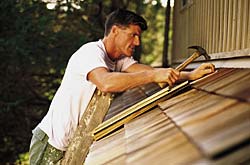To Vent or Not to Vent? What is Better for Thy Roof?
See if We Have Top-Rated
Home Professionals in Your Area

According to the U.S. Army Corps of Engineers, in the United States more than $12 billion is spent every year on re-roofing with nearly three-quarters of the damage being caused by some type of moisture damage. Ice dams, saturated insulation, wood rot, and condensation so bad it gets confused as a roof leak are some of the more common and easily prevented problems that roof ventilation can help resolve. Roof ventilation is far from a sure thing. Poorly designed roof vents or the assumption that all ventilation is good ventilation can cause more problems than they fix. So, just like high school Shakespeare, here are the crib notes for the typical homeowner.
Hamlet's Ghost: The Real Enemy of Residential Roofing
A downtrodden Hamlet once remarked that this most excellent canopy, "this brave o'erhanging firmament, this majestical roof fretted with golden fire," appeared to him as "nothing but a foul and pestilent congregation of vapors." While this calamitous character was hardly known for calling it like it is, many homes actually enact this drama, where a roof appears beautiful but turns ugly from excessive heat in the summer and moisture damage in the winter.
And just like Hamlet, who was beset with both internal and external forces, your roof is fighting a war on two fronts. Moisture-laden air commonly leaches from your home's living space into your attic. This air condenses on roof sheathing or insulation and will lead to poor insulating qualities at best and rot and roof failure at worst. Meanwhile, snow or wind-driven rain can back-up into your roof, causing ice dams and extensive water damage.
Mistaken Identity: Identify Moisture Problems before Acting
Hamlet sealed his fate when he mistakenly stabbed Polonius. So, too, don't assume that moisture in your attic is necessarily the fault of the attic. Controlling any moisture problems in the rest of your house should be the top priority to systematically eliminate excessive moisture in the home. Just because you have moisture in your attic doesn't mean ventilation is the solution. Likewise, just because you install roof vents doesn't mean your moisture problem automatically goes away. "Don't rely on ventilation alone to take care of moisture in the attic," says William Rose of the Building Research Council at the University of Illinois. "The best protection against condensation and mildew in the attic is a dry basement or crawlspace. Also important is an airtight ceiling."
Time for a new roof? We can help! Use this link to
Install a Roof
The Globe Theater Rebuilt: Is Roof Ventilation Outdated in New Homes?
With its open roof design, Shakespeare's theater had little need for additional ventilation. By contrast, many modern homes are constructed without any roof ventilation. Unlike older roofing systems, however, modern roofs are designed to avoid common moisture problems without a ventilation system. Unvented roofing systems essentially move the attic into the conditioned space of a home, installing the air barrier and thermal boundary on the underside of the roof, rather than the ceiling (or attic floor). This creates several benefits: you can install ductwork in your attic without energy loss, the reinforced soffits will help protect your home during hurricanes or severe storms, unvented roofs help slow the spread of wildfires, and it may be impractical to install an airtight barrier in your ceiling with more complicated roofing designs.
That said, unvented roofs cost more to install. If you're trying to save some money on the construction of a new home, conventional roofing and ventilation might still be the way to go. Keep in mind, however, that once your home is built, little can be done to change the design of your roof, while interior improvements can always be added later. This is what one homeowner, who's building a new home in northern Idaho, said, "A roof is not a fancy item—it's a basic item that must be as good as one can possibly afford. Who cares about granite [counters] when there are leaks or it's cold because the wind can blow inside of the house?"
The Solution: Avoid Hamlet's Inability to Act
If you're unsure about the wisdom of installing roof vents, rather than attempting to sift through tons of seemingly contradictory and technical literature, you should contact a local roofing professional. With new construction, your builder should be to answer any questions you have about various roof designs. With the trickier prospect of retrofitting a home, hire an independent roof inspector. You should be having your roof inspected at least once a year, anyway. These professionals are your best resource. Beyond just hurricanes and wildfires, regional climatic factors, such as annual snowfall and temperature swings, can play a decisive role in determining the best solution for your roof. A local, qualified roof inspector will be able to analyze the current condition of your roof, make a long-term prognosis, and lay out your options for roof ventilation and comprehensive roof maintenance.

